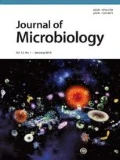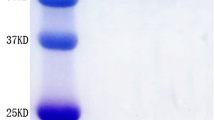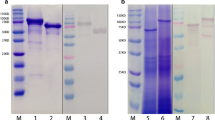Abstract
Streptococcus pneumoniae is a leading cause of infectious diseases in children under 5-year-old. Vaccine has been used as an indispensable strategy to prevent S. pneumoniae infection for more than 30 years. Our previous studies confirmed that mucosal immunization with live attenuated strain SPY1 can protect mice against nasopharyngeal colonization of S. pneumoniae and lethal pneumococcal infection, and the protective effects are comparable with those induced by commercially available 23-valent polysaccharide vaccine. However, live attenuated vaccine SPY1 needs four inoculations to get satisfactory protective effect, which may increase the risk of virulence recovery. It is reported that heterologous primeboost approach is more effective than homologous primeboost approach. In the present study, to decrease the doses of live SPY1 and improve the safety of SPY1 vaccine, we immunized mice with SPY1 and DnaJ protein alternately. Our results showed that heterologous prime-boost immunization with SPY1 and DnaJ protein could significantly reduce the colonization of S. pneumoniae in the respiratory tract of mice, and induce stronger Th1 and Th17 cellular immune responses than SPY1 alone. These results indicate heterologous prime-boost immunization method not only elicits better protective effect than SPY1 alone, but also reduces the doses of live SPY1 and decreases the risk of SPY1 vaccine. This work is the first time to study the protective efficiency with two different forms of S. pneumoniae candidate vaccine, and provides a new strategy for the development of S. pneumoniae vaccine.
Similar content being viewed by others
References
Babb, R., Chen, A., Hirst, T.R., Kara, E.E., McColl, S.R., Ogunniyi, A.D., Paton, J.C., and Alsharifi, M. 2016. Intranasal vaccination with gamma-irradiated Streptococcus pneumoniae whole-cell vaccine provides serotype-independent protection mediated by B-cells and innate IL-17 responses. Clin. Sci. (Lond) 130, 697–710.
Blair, C., Naclerio, R.M., Yu, X., Thompson, K., and Sperling, A. 2005. Role of type 1 T helper cells in the resolution of acute Streptococcus pneumoniae sinusitis: a mouse model. J. Infect. Dis. 192, 1237–1244.
Bogaert, D., de Groot, R., and Hermans, P.W.M. 2004. Streptococcus pneumoniae colonisation: the key to pneumococcal disease. Lancet Infect. Dis. 4, 144–154.
Cui, Y., Zhang, X., Gong, Y., Niu, S., Yin, N., Yao, R., Xu, W., Li, D., Wang, H., He, Y., et al. 2011. Immunization with DnaJ (hsp40) could elicit protection against nasopharyngeal colonization and invasive infection caused by different strains of Streptococcus pneumoniae. Vaccine 29, 1736–1744.
Fioretti, D., Iurescia, S., Fazio, V.M., and Rinaldi, M. 2010. DNA vaccines: developing new strategies against cancer. J. Biomed. Biotechnol. 2010, 174378.
Golshani, M., Rafati, S., Siadat, S.D., Nejati-Moheimani, M., Shahcheraghi, F., Arsang, A., and Bouzari, S. 2015. Improved immunogenicity and protective efficacy of a divalent DNA vaccine encoding Brucella L7/L12-truncated Omp31 fusion protein by a DNA priming and protein boosting regimen. Mol. Immunol. 66, 384–391.
Jahn-Schmid, B., Messner, P., Unger, F.M., Sleytr, U.B., Scheiner, O., and Kraft, D. 1996. Toward selective elicitation of TH1-controlled vaccination responses: vaccine applications of bacterial surface layer proteins. J. Biotechnol. 44, 225–231.
Li, P., Cao, R.B., Zheng, Q.S., Liu, J.J., Li, Y., Wang, E.X., Li, F., and Chen, P.Y. 2010. Enhancement of humoral and cellular immunity in mice against Japanese encephalitis virus using a DNA primeprotein boost vaccine strategy. Vet. J. 183, 210–216.
Li, W., Wang, S., and Lu, S. 2013. Pilot study on the use of DNA priming immunization to enhance Y. pestis LcrV-specific B cell responses elicited by a recombinant LcrV protein vaccine. Vaccines (Basel) 2, 36–48.
Liu, S., Shi, D., Wang, H.C., Yu, Y.Z., Xu, Q., and Sun, Z.W. 2015. Co-immunization with DNA and protein mixture: a safe and efficacious immunotherapeutic strategy for Alzheimer’s disease in PDAPP mice. Sci. Rep. 5, 7771.
Liu, Y., Wang, H., Zhang, S., Zeng, L., Xu, X., Wu, K., Wang, W., Yin, N., Song, Z., Zhang, X., et al. 2014. Mucosal immunization with recombinant fusion protein DnaJ-DeltaA146Ply enhances crossprotective immunity against Streptococcus pneumoniae infection in mice via interleukin 17A. Infect. Immun. 82, 1666–1675.
Lorin, C., Vanloubbeeck, Y., Baudart, S., Ska, M., Bayat, B., Brauers, G., Clarinval, G., Donner, M.N., Marchand, M., Koutsoukos, M., et al. 2015. Heterologous prime-boost regimens with a recombinant chimpanzee adenoviral vector and adjuvanted F4 protein elicit polyfunctional HIV-1-specific T-Cell responses in macaques. PLoS One 10, e0122835.
Lu, S. 2009. Heterologous prime-boost vaccination. Curr. Opin. Immunol. 21, 346–351.
Lu, S. 2011. Two is better than one. Lancet. Infect. Dis. 11, 889–891.
Lu, Y.J., Gross, J., Bogaert, D., Finn, A., Bagrade, L., Zhang, Q., Kolls, J.K., Srivastava, A., Lundgren, A., Forte, S., et al. 2008. Interleukin-17A mediates acquired immunity to pneumococcal colonization. PLoS Pathog. 4, e1000159.
Magalhaes, I., Sizemore, D.R., Ahmed, R.K., Mueller, S., Wehlin, L., Scanga, C., Weichold, F., Schirru, G., Pau, M.G., Goudsmit, J., et al. 2008. rBCG induces strong antigen-specific T cell responses in rhesus macaques in a prime-boost setting with an adenovirus 35 tuberculosis vaccine vector. PLoS One 3, e3790.
Moffitt, K.L. and Malley, R. 2011. Next generation pneumococcal vaccines. Curr. Opin. Immunol. 23, 407–413.
Mook-Kanamori, B.B., Geldhoff, M., van der Poll, T., and van de Beek, D. 2011. Pathogenesis and pathophysiology of pneumococcal meningitis. Clin. Microbiol. Rev. 24, 557–591.
Nand, K.N., Gupta, J.C., Panda, A.K., Jain, S.K., and Talwar, G.P. 2015. Priming with DNA enhances considerably the immunogenicity of hCG ß-LTB vaccine. Am. J. Reprod. Immunol. 74, 302.
Nguyen, C.T., Kim, S.Y., Kim, M.S., Lee, S.E., and Rhee, J.H. 2011. Intranasal immunization with recombinant PspA fused with a flagellin enhances cross-protective immunity against Streptococcus pneumoniae infection in mice. Vaccine 29, 5731–5739.
O’Brien, K.L., Wolfson, L.J., Watt, J.P., Henkle, E., Deloria-Knoll, M., McCall, N., Lee, E., Mulholland, Kim, Levine, O.S., Cherian, T., et al. 2009. Burden of disease caused by Streptococcus pneumoniae in children younger than 5 years: global estimates. Lancet 374, 893–902.
Pilishvili, T., Lexau, C., Farley, M.M., Hadler, J., Harrison, L.H., Bennett, N.M., Reingold, A., Thomas, A., Schaffner, W., Craig, A.S., et al. 2010. Sustained reductions in invasive pneumococcal disease in the era of conjugate vaccine. J. Infect. Dis. 201, 32–41.
Roche, A.M., King, S.J., and Weiser, J.N. 2007. Live attenuated Streptococcus pneumoniae strains induce serotype-independent mucosal and systemic protection in mice. Infect. Immun. 75, 2469–2475.
Rodrigo, C. and Lim, W.S. 2014. The relevance of pneumococcal serotypes. Curr. Infect. Dis. Rep. 16, 403.
Wang, Y., Jiang, B., Guo, Y., Li, W., Tian, Y., Sonnenberg, G.F., Weiser, J.N., Ni, X., and Shen, H. 2016. Cross-protective mucosal immunity mediated by memory Th17 cells against Streptococcus pneumoniae lung infection. Mucosal Immunol. 10, 250–259.
Weinberger, D.M., Malley, R., and Lipsitch, M. 2011. Serotype replacement in disease after pneumococcal vaccination. Lancet 378, 1962–1973.
WHO. 2012. Pneumococcal vaccines WHO position paper—2012. Wkly. Epidemiol. Rec. 87, 129–144.
WHO. 2013. Progress in introduction of pneumococcal conjugate vaccine worldwide, 2000–2012. Wkly. Epidemiol. Rec. 88, 173–180.
Wilson, R., Cohen, J.M., Jose, R.J., de Vogel, C., Baxendale, H., and Brown, J.S. 2015. Protection against Streptococcus pneumoniae lung infection after nasopharyngeal colonization requires both humoral and cellular immune responses. Mucosal Immunol. 8, 627–639.
Wu, K., Yao, R., Wang, H., Pang, D., Liu, Y., Xu, H., Zhang, S., Zhang, X., and Yin, Y. 2014. Mucosal and systemic immunization with a novel attenuated pneumococcal vaccine candidate confer serotype independent protection against Streptococcus pneumoniae in mice. Vaccine 32, 4179–4188.
Wu, K., Zhang, X., Shi, J., Li, N., Li, D., Luo, M., Cao, J., Yin, N., Wang, H., Xu, W., et al. 2010. Immunization with a combination of three pneumococcal proteins confers additive and broad protection against Streptococcus pneumoniae infections in mice. Infect. Immun. 78, 1276–1283.
Xu, X., Meng, J., Wang, Y., Zheng, J., Wu, K., Zhang, X., Yin, Y., and Zhang, Q. 2014. Serotype-independent protection against pneumococcal infections elicited by intranasal immunization with ethanol-killed pneumococcal strain, SPY1. J. Microbiol. 52, 315–323.
Xu, X., Wang, H., Liu, Y., Wang, Y., Zeng, L., Wu, K., Wang, J., Ma, F., Xu, W., Yin, Y., et al. 2015. Mucosal immunization with the live attenuated vaccine SPY1 induces humoral and Th2-Th17-regulatory T cell cellular immunity and protects against pneumococcal infection. Infect. Immun. 83, 90–100.
Yan, W., Wang, H., Xu, W., Wu, K., Yao, R., Xu, X., Dong, J., Zhang, Y., Zhong, W., and Zhang, X. 2012. SP0454, a putative threonine dehydratase, is required for pneumococcal virulence in mice. J. Microbiol. 50, 511–517.
Author information
Authors and Affiliations
Corresponding author
Rights and permissions
About this article
Cite this article
Qiu, Y., Zhang, X., Wang, H. et al. Heterologous prime-boost immunization with live SPY1 and DnaJ protein of Streptococcus pneumoniae induces strong Th1 and Th17 cellular immune responses in mice. J Microbiol. 55, 823–829 (2017). https://doi.org/10.1007/s12275-017-7262-1
Received:
Revised:
Accepted:
Published:
Issue Date:
DOI: https://doi.org/10.1007/s12275-017-7262-1




